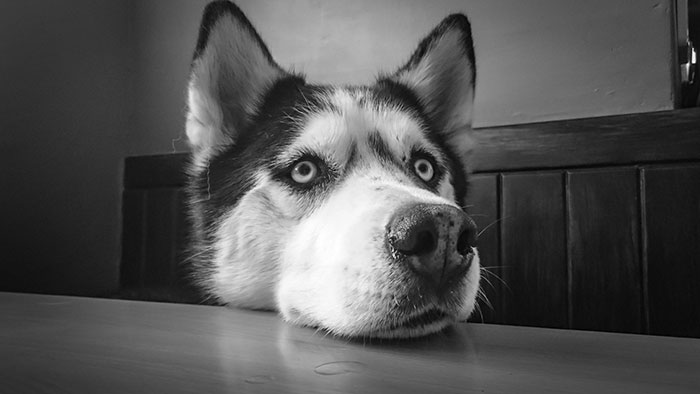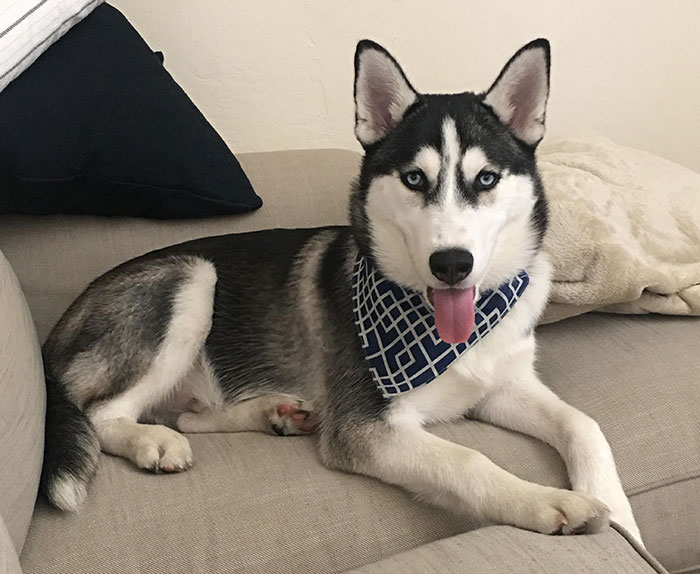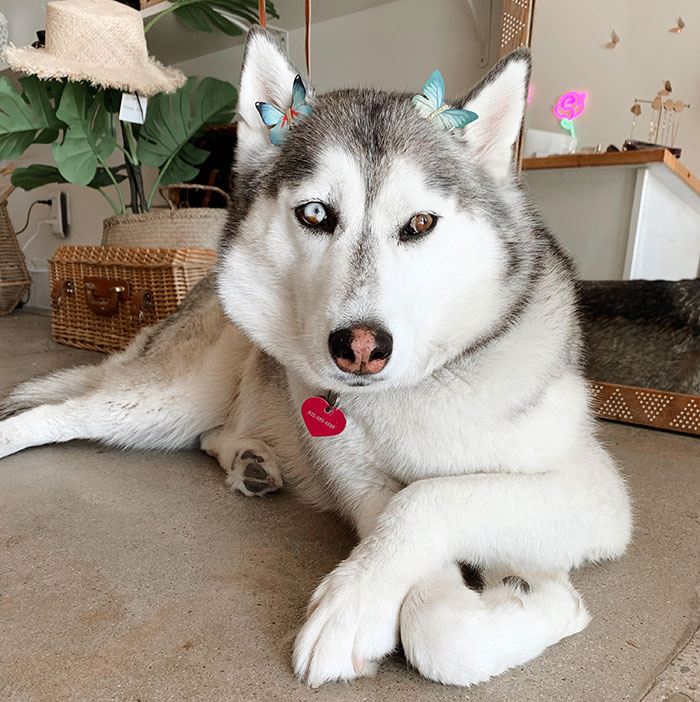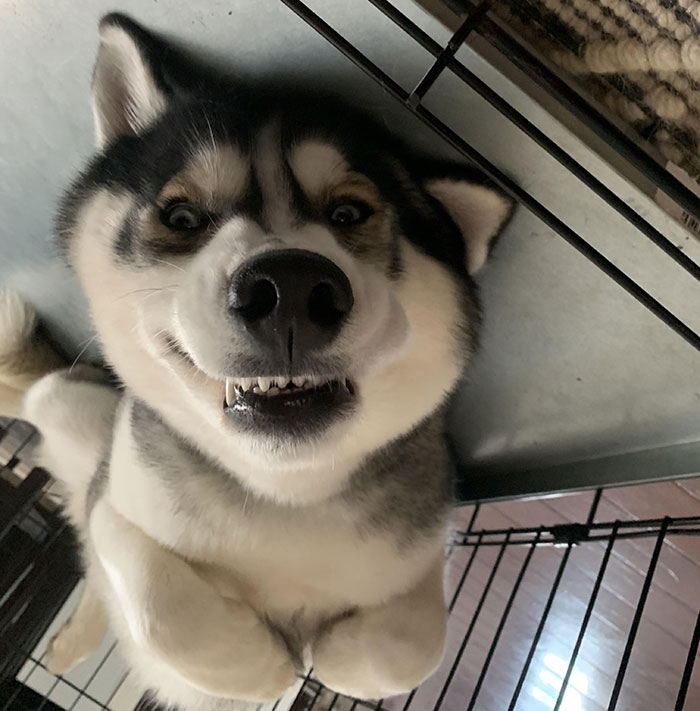The Alaskan Husky is a versatile working dog bred for its endurance, strength, and speed. As a sled dog, this crossbreed is an integral part of the history and culture of Alaska and Canada. While not a standardized breed, the Alaskan Husky is a unique blend of various Nordic breeds, carefully selected by breeders based on their desired characteristics.
- Alaskan Husky's coat varies; no set color or pattern standard.
- High energy level; Alaskan Huskies require ample exercise.
- Alaskan Huskies differ from Siberian Huskies in size and stamina.
If you are bringing home an Alaskan husky and wants to know all about this dog, you are at the right place. In this article, we will be highlighting the origin, temperament, health, grooming and other characteristics of this breed.
The information provided herein is for informational purposes only. Please refer to our disclaimer for more details..
Quick Facts:
- The Alaskan Husky is a versatile working dog bred for endurance, strength, and speed.
- It is not a standardized breed but a blend of various Nordic breeds, selected for specific traits by breeders. They are genetically related to Alaskan malamutes and Siberian huskies.
- Lifespan: 10 to 15 years
- They have strong pack instincts. A pup slowly learns to accept the family as part of a social hierarchy, a pack as it grows into an adult.
- They cannot thrive in warmer climates, as they are used to the cold climate of Alaska, where temperature drops below freezing point.
- An adult Alaskan husky may pull up to 80 kg weight including the sled weight.
- Performance dogs can reach speeds of 45 km/hr.
- They vary greatly in appearance, one of the most common features is their prick ears, but no set standard for their coat color or pattern.
- They are affectionate, friendly, and can make great companions if their exercise needs are met.
- They are best suited for active families who can provide ample physical activity and mental stimulation.
Alaskan Husky Breed Overview
Image credit: Pixabay
Alaskan Huskies are bred for their working ability, not for looks or pedigree. They are not purebred and are crafted by mixing various breeds into the spitz type husky blood lines. These versatile dogs come in a variety of appearances, but they generally have a medium build and weigh between 35 to 75 pounds
Temperament-wise, Alaskan Huskies are known for their affectionate nature. They are sociable and friendly with people and other dogs, making them excellent companions. These intelligent dogs are trainable, but they can also have a mind of their own, which requires a firm and consistent pack leader.
Alaskan Huskies have high energy levels and need plenty of physical exercise to prevent destructive behavior. Regular exercise, such as long walks or outdoor activities, is essential to keep them happy and fulfilled. You may want to consider opting for this dog if you are athletic and love to hike.
Breed History and Origin
Indigenous dogs in Alaska were known for their strength and stamina to pull freight across long distances, they caught the attention of European traders and settlers that arrived in Alaska in the early 20th century. These traders were looking for some entertainment and were fond of sports like sled pulling and sprint race competitions.
They began breeding the local dogs that had stamina but lack speed with the Siberian imports, this inculcated the husky heritage in these dogs, most commonly Siberian husky and Alaskan malamute has a close genetic lineage with the Alaskan Husky. Other spitz-like breed dogs used were, Greenland dog, Mackenzie River husky, Samoyed and Eskimo dog.
By the mid of 20th century, the sled dogs use was shifted to sports and two variants were formed:
1)The distance group: the adult dog of this category has a double coat and is supposed to cover longer distances in harsh climates, therefore these blood lines had more contribution from Alaskan malamute, Siberian huskies and long coat mountain dogs like Great Pyrenees.
2)The Sprint group: this category was supposed to be more agile for short distance sprint games, so breeders choose gundogs and racing dogs for the purpose of adding speed, for instance: Pointers, Greyhounds and Salukis contributed for the cause.
Because of the fact that Alaskan husky is an amalgam of different breeds, no kennel club recognizes this breed as a purebred dog.
Size and Appearance:
The Alaskan Husky typically has a medium-sized build and a short to medium-length coat that can come in a variety of colors and patterns. Their appearance varies widely as their genetic makeup prioritizes working ability over conformity to a specific breed standard. With their characteristic prick ears and expressive eyes, Alaskan Huskies exhibit an unmistakable charm.
Height : An adult dog stands at 20 to 25 inches at shoulder height Weight: An adult weigh around 35 to 75 pounds
Alaskan Husky Care and Exercise Needs
Image credit: jas_star
Alaskan Huskies need regular exercise to maintain their physical and mental well-being. They have a strong desire to run and pull, so it’s important for their owners to be athletic and provide them with enough exercise and opportunities to engage in physical activities. Provide them with enough living space for mobility, they are active dogs and are not suitable for small living apartments.
Regular exercise is essential to keep Alaskan Huskies happy and prevent destructive behavior. Activities like running, hiking, or participating in dog sports can help fulfill their need for physical stimulation and tire them out. Moreover, it is also important to provide a balanced diet with optimum levels of protein and carbs, these dogs were bred for increased hunger, remember not to overfeed to prevent obesity.
Temperament and Personality
In terms of temperament, Alaskan Huskies are known for their friendly and sociable nature. They are gentle, playful, and generally get along well with people and other dogs. Due to their friendly disposition, though, they may not be the best choice as watchdogs. Instead, their sociability and willingness to interact make them excellent companions for families and individuals seeking an active and engaging four-legged friend.
They are prone to separation anxiety if left alone for a long time.
However, due to a blend of different breeds one can witness a variation in personality traits of these dogs, they can be friendly and outgoing but some individuals may shy away, one can never be so sure how the dog will behave. Early socialization and training is the key to developing a well rounded and balanced personality.
This dog is quite active and needs a lot of exercise to keep it busy and fulfill the physical and mental needs to recreate. They love to pull and go long distances, always remember to keep them on leash and ready to run alongside because they are not content with short walks by the street.
They love to explore their surroundings, may have a high prey drive and dig the lawn out of boredom, therefore, it’s a good idea to use a fence that can’t be dug. An owner with an active lifestyle and love for hiking will be suitable match for this dog’s longing for adventure.
Training and Socialization:
Alaskan Huskies are intelligent and trainable dogs, although they can have an independent streak. When it comes to training, positive reinforcement techniques are highly effective with them. Praising, playing, and using treats can motivate and encourage their learning.
They possess a strong work ethic and are quick to understand new commands and tasks. However, it’s important to note that they may also have a mind of their own, requiring a firm and consistent pack leader to establish boundaries and maintain control during training sessions.
Alaskan Huskies require early socialization more than any other dog because of the mixed personality traits and an independent nature of its own. Start socializing your Alaskan husky puppy at an early age of puppyhood at eight weeks to ensure that the puppy is familiarized with its environment including people and other pets, this will boost its confidence and help raise a well- balanced social dog. You can always go for professional training but that has a cost to it.
Grooming
Image credit: davidknighter
Grooming is another important aspect of caring for an Alaskan Husky. They have a short to medium-length coat that sheds twice a year, this requires regular brushing to remove dead and loose hair, especially during shedding season. This helps keep their coat healthy and prevents matting. Want to learn more?, here is a list of dogs that shed the most.
- Regular nail trimming is necessary to keep their nails at a manageable length.
- Ear cleaning is important to prevent the buildup of dirt and wax, which can lead to infections.
- Dental hygiene should also be prioritized to maintain their oral health and prevent dental issues.
Common Health Issues
As with all dogs, Alaskan Huskies can be prone to certain health conditions. It is essential for potential owners to be aware of these issues in order to provide appropriate care and ensure the well-being of their beloved pets. Some common health problems that can affect Alaskan Huskies include:
Hip Dysplasia ( a genetic health issue )
Hip dysplasia is a genetic condition that affects the hip joints. It can cause lameness, pain, and difficulty in movement. Regular exercise and maintaining a healthy weight can help reduce the risk of hip dysplasia in Alaskan Huskies.
Eye Problems
They may be susceptible to various eye problems, including progressive retinal atrophy, which can lead to vision loss over time. Regular eye examinations by a veterinarian can help detect and manage any eye conditions early on.
Hypothyroidism
Hypothyroidism is a hormonal disorder that can affect Alaskan Huskies. It occurs when the thyroid gland does not produce enough thyroid hormone. Common symptoms include weight gain, lethargy, and hair loss. Regular veterinary check-ups and blood tests can help diagnose and manage this condition.
When choosing an Alaskan Husky, it is crucial to buy from a reputable breeder who conducts health screenings and provides a health guarantee. Regular veterinary check-ups and preventive care are also essential in maintaining the overall health and well-being of your Alaskan Husky. By being proactive and informed about potential health issues, you can help ensure a long and happy life for your beloved companion.
Alaskan Husky as a Family Companion
While Alaskan Huskies are primarily bred for working or competitive purposes, they can also be excellent family companions. These dogs are known for their affectionate nature and friendly demeanor towards their families. They particularly get along well with children, making them a great choice for families with kids.
However, it’s important to note that Alaskan Huskies have high energy levels and require plenty of exercise and mental stimulation. They thrive in active households where they can participate in various activities such as running, hiking, or engaging in dog-powered sports like skiing. Regular exercise helps them channel their energy and prevent behavioral issues that may arise when left under-stimulated.
Alaskan Husky as a Sled Dog
Image credit: PatientWriting
Alaskan Huskies are renowned for their exceptional versatility in a wide range of dog sports. These agile and athletic dogs are not only talented sled dogs but also excel in various other dog-powered activities, showcasing their intelligence, trainability, and remarkable physical abilities. They are excellent working dogs and known to pull heavy loads to great distances without getting tired.
One of the primary areas where Alaskan Huskies shine is in dog sledding. With their incredible endurance, strength, and speed, these dogs effortlessly navigate through snowy terrains, pulling sleds with great power and agility. They are the heart and soul of sled racing, consistently proving their dominance in this thrilling sport.
Furthermore, Alaskan Huskies are also utilized in tasks such as hauling heavy loads and delivering supplies to remote locations. Their ability to work in harsh conditions, enduring extreme temperatures and difficult landscapes, has made them highly valued in these demanding roles.
What sets Alaskan Huskies apart in dog sports is not only their physical prowess but also their friendly and sociable nature. They form strong bonds with their handlers and team members, making them cooperative and highly effective in group endeavors. Their enthusiastic and adaptable nature allows them to work seamlessly with other dogs, which is crucial in sports where teamwork is essential.
Alaskan Husky dogs Vs. Siberian Huskies
Alaskan huskies are closely knit to Siberian huskies and Alaskan malamutes that people often confuse these two. The first and foremost difference is that the latter are purebred dogs, whereas the former is a mixed-breed dog. Moreover, a typical Alaskan husky is taller and leaner, has more stamina and is agile compared to its Siberian counterpart, and has brown eyes, compared to different shades in the later.
Conclusion
The Alaskan Husky is a remarkable and versatile working dog breed known for its endurance, strength, and speed. With their medium-sized frame and short to medium-length coats, these dogs are not only strikingly beautiful but also excel in various dog-powered sports, particularly dog sledding. Their incredible athleticism and friendly demeanor make them suitable family companions, as long as their exercise and mental stimulation needs are met.
Proper care for an Alaskan Husky involves regular exercise, grooming, and routine veterinary check-ups. Their health should be closely monitored, as certain genetic conditions such as hip dysplasia, eye problems, and hypothyroidism can affect them. With their unique appearance and variability, Alaskan Huskies are truly exceptional working dogs that have earned a special place in the hearts of dog enthusiasts worldwide.
182views
Share on Facebook
 Dark Mode
Dark Mode 

 No fees, cancel anytime
No fees, cancel anytime 






















































-1
0